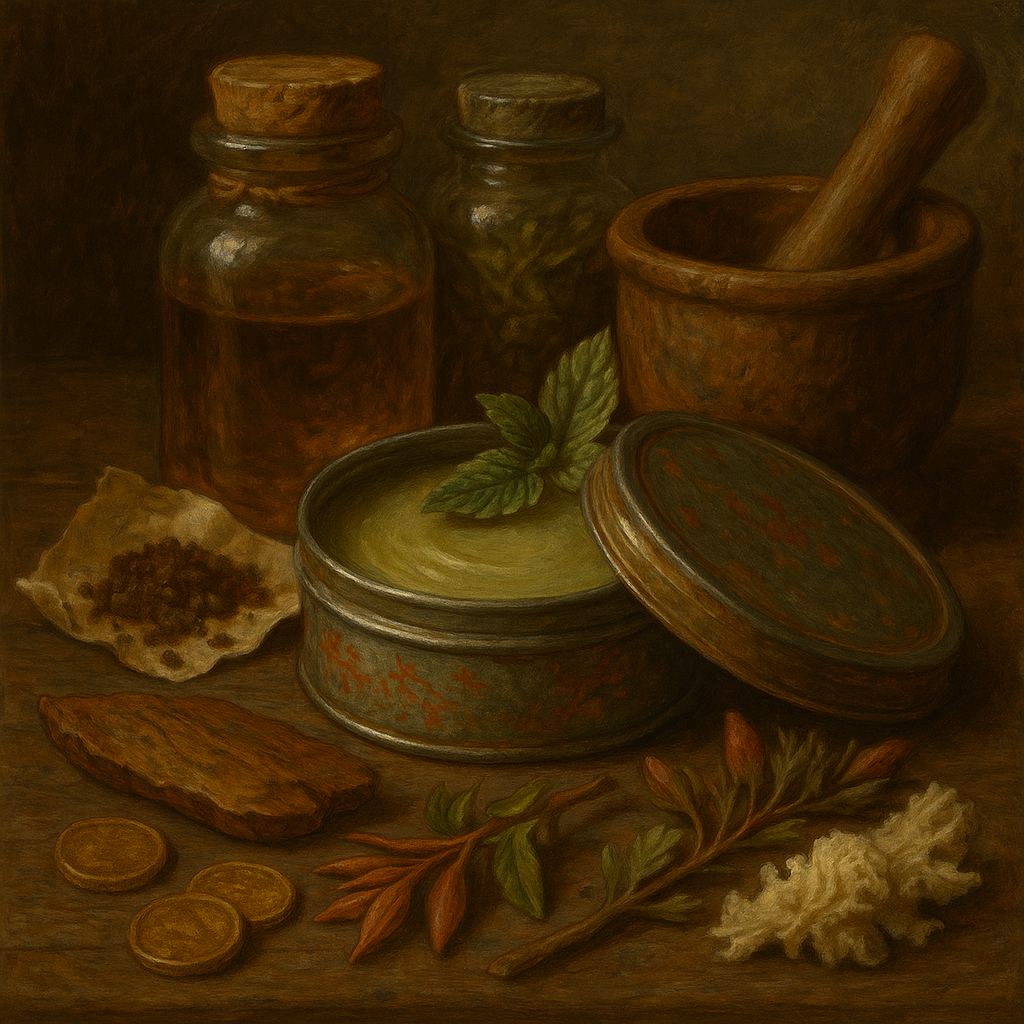Salves
"If a poultice is a scream, then a salve is a whispered apology." -Old hedge-physic, inked in soot along a garden gate in Halt-Cliff.
In the world of Everwealth, salves occupy a gentler, subtler corner of healing, though not always a safer one. Where poultices are crude battles of alchemy and desperation, salves are whispered spells in grease, slow alchemical sighs that soothe, seep, and soften. Salves are used to calm burns, mend skin, lull inflamed joints, or quiet the ghosts of infection humming beneath the flesh. Yet behind their sweet scents and buttery textures lie dangers of their own: magickal interference, misaligned ingredients, spiritual soaking, or slow rot beneath a perfect seal. Improperly prepared salves may seal infection beneath the skin, suffocate tissue, or act as arcane conduits to wandering spirits. Always test a drop first. If it screams, bubbles, or smells of sweet rot, do not apply. A salve is neither miracle nor mistake. It is a hope, rubbed thin. In the harsh lands of Everwealth, where true healing is rare and comfort rarer, a good salve may not save your life. But it might let you keep walking a little longer.
Mechanics & Inner Workings
Salves operate by permeating the skin's surface, allowing infused herbs, oils, and magickal residues to spread locally or systemically. Unlike poultices, which rely on pressure and patch-binding, salves rely on absorption, often activated by warmth, breath, or subtle rituals. Some salves require recitation of specific verses while rubbing, others activate under moonlight, and a few respond to the pulse of the wearer. They function on a balance between chemical remedy and subtle sympathetic magicks. Well-made salves are absorbed fully into the skin within minutes, leaving little residue behind. The best may ease pain, fight infection, or restore mobility within hours. The worst? They trap sickness inside like a sealed tomb, or cause dreams of ash and bone until the soul forgets itself.
Manufacturing process
- Base Selection - Animal fats (like ox-tallow or marrow-fat), beeswax, or root-based gels form the salve’s base. Spirit-infused fats from creatures like night-boars or marrow-hares are reserved for spiritual or magickal salves.
- Infusion - Herbs, minerals, and reagents are simmered into the base over low fire or slow coals for hours. This is often done during lunar phases to bind arcane resonance.
- Straining & Thinning - The mixture is strained through ash-cloth or bone sieve and thinned with alcohol, vinegar, or moonwater.
- Cooling & Setting - Some are set in carved wooden trays, others in wax-sealed jars or thick-leaved wraps.
- Binding Ritual (Optional) - For salves meant to treat curses, spiritual wounds, or soul-fracture, a final step involves inscribing protective runes or embedding threads of blessed silk.
History
The earliest salves in recorded Everwealthy lore came from Smallfolk refugees around the region that would become Twin-Peak, who treated sand-burns and blistering rashes with cactus sap and marrow-fat; THough like many things in our history today for all we know salves predate many of the ruins we have been picking over the last 500 years by 1,000. During The Great Schism, when healing magic waned and disease surged, The Scholar's Guild began hoarding salve recipes. Many of the oldest blends were lost, burned, or locked behind alchemical wards too complex to unweave. Rural hedge-physickers and lowland midwives preserved others through song, tattoo, or memory. Some noble houses still pass down ‘blood-salve’ recipes as heirlooms, said to cure ailments only suffered by their cursed lineage. Meanwhile, in the slums and borders, salves have become a currency of care: shared between neighbors in hidden tins, or bartered in alleys for bread and protection.
Significance
Salves embody what little comfort can still be found in Everwealth: a return to stillness, a quiet fire, the flicker of hope when pain fades just long enough to dream. Yet they are not without controversy. Some alchemists consider salves inefficient compared to injections or potions. Others argue that spiritual salves are heretical, inviting old powers to linger too long on the skin. Still, in a kingdom stitched with scars, the salve remains a whispered legacy: not always a cure, but often enough to keep someone alive one more day.
Creation Date
Unknown; believed to have originated before the Civil Age.
Destruction Date
Not applicable, though some salve types have been outlawed by regional powers for their association with blood rites or heretical cults..
Rarity
Commonplace among trained healers and herbalists, but rare are those with blends that fully lack side effects. Certain enchanted salves are unique to region, maker, or bloodline.
Weight
Approximately 0.1 to 0.5 lbs per tin.
Dimensions
Stored in jars, tins, or folded wax packets. Sizes range from coin-width to palm-sized trays.
Base Price
Typically 2-5 Capras (an average day's wages) per dose. Rarer, arcane-bound salves can fetch over 10 Capra or require trade in memories, names, or oaths.
Raw materials & Components
Ashmilk Resin: Used for its soothing properties on burns, but can induce slow dreams.
Goldbark Oil: Anti-inflammatory; when spoiled, becomes acidic.
Bleeding Root: Promotes clotting; addictive in large doses.
White Fungus Wax: Cooling agent; may invite ghost-touch if harvested during eclipse.
Everwood Sap: Relieves nerve pain; considered mildly hallucinogenic.
Spineleaf Paste: Numbs the skin; used in surgery or torture.
Cindersoot: Prevents magickal rot, but blackens the wound and smells of charcoal.
Tools
- A ladle or iron stir-paddle.
- Ash-straining and particle sifting cloths.
- Carved salve trays (marked with healer's rune).
- Fire-bowls and cauldrons for slow infusion.



Comments